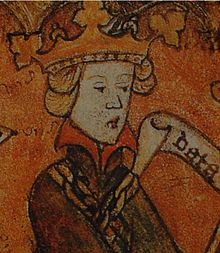| Carl I | |
|---|---|

| |
| Carl I | |
| King of Svealand | |
| Reign | 15th February, 1311 - 19th August 1337 |
| Predecessor | Magnus III |
| Successor | Olaf II |
| Born | September, 1287 Nyköping, Svealand |
| Died | 19th August, 1337 Birka, Svealand |
| Spouse | Katarina of Stockholm Beatrice of Anhalt |
| Issue | Eric Elizabeth |
| Full name | |
| Carl Ericsson | |
| House | Eric |
| Father | Eric VIII |
| Mother | Märta of Håtuna |
Carl I was the last king from the Eric Dynasty, and the last king of an independent Svealand, before it broke free of Danish control in the mid 16th century.
His grandfather, Birger of Nyköping, and father Eric VIII before him had challenged John III and Magnus III respectively for the crown of Svealand and Carl would spend his teens as a hostage of Magnus III to ensure Eric did not attempt an invasion. When Magnus died in 1311, Carl was released and proclaimed king over Magnus' own children, a sure sign that many prominent lords had tired of Magnus' legacy. This signalled another twist in the fortunes of the various branches of the House of Eric who had been fighting over the Svealandic crown since 1261. However Carl's position was not assured. Whilst many supported him there were a great many others who supported Magnus' sons or even Eric II of Finland's children. Carl, or his advisors, historians are divided over who should shoulder the blame, therefore embarked on a bloody spree to remove dissent. This culminated in the 'Stockholm Bloodbath' in which all of Magnus' children still in Svealand, both legitimate and otherwise, were butchered.
The next few years were no less fevered as famine hurt Svealand considerably and Carl was forced to debase the coinage and rule ever more dictatorially. In 1323 he would lead a war in Finland, ostensibly to shore up the duchy's borders and repel Novgorod's advances but probably more to show his lords who was boss. If this was his aim it failed. Novgorod scored a victory over the Svealandic forces and Carl would be forced to sign the Treaty of Noteborg which limited Finland to the lands Eric II had controlled.
The treaty signalled a turning point in Carl's reign. With no outward outlet for his lords' energies domestic politics darkened. Some of his lords looked elsewhere for work, bringing them into the orbit of Olaf III of Viken. In 1333 Olaf declared Carl's rule unlawful and invaded Svealand. Svealand had been ruled by the House of Rugia from 1221 to 1261 but Viken had not been involved in any of the civil war so far. It is unclear whether Olaf had always thought this and had simply found the time right or whether it was pure opportunism but Carl would be defeated at the Battle of Broo and as his support collapsed was forced to sign the Treaty of Uppsala. This made Olaf his sole heir in Svealand, effectively disinheriting his children.
For the remainder of his reign Carl vainly attempted to restore his authority and potentially fight to overturn the settlement. He would die in 1337 and as soon as the news arrived Olaf travelled to Uppsala to seize the throne. Inevitably there was opposition and Carl's sons Eric and John commanded a considerable force which would prevent Olaf being crowned until 1342. Olaf granted the land north of Lake Vanern (Värmland) to Gothenland for its assistance in the original invasion, and its neutrality in the ensuing 'Carlssons' War'.
Even before Olaf's propagandists set to work Carl's reign was described was described in terms of cruelty, wasted opportunities or plain stupidity. Though historians generally agree Olaf's rule would be more onerous in terms of taxes, he did provide long-term stability to the country, a reformed legal code and a new coinage. Moreover he allowed the lords a wider playing field to work out their feuds and issues on, with campaigns in Finland, Novgorod and eventually in Germany to keep them busy. Tying the lords to the Vikene, and then Danish crowns would more than anything help to stifle the lingering resentments from the civil war and pacify the turbulent country.
| |||||||||||||||||||||||||||||||||||||
| ||||||||||||||||||||


